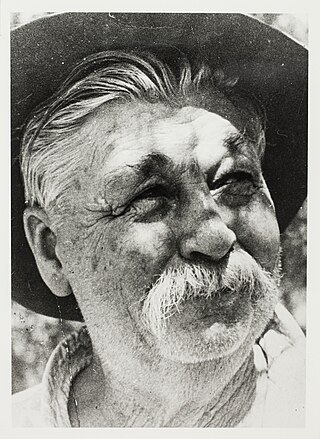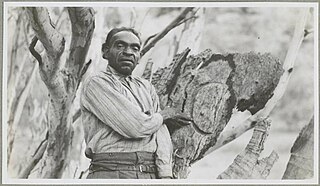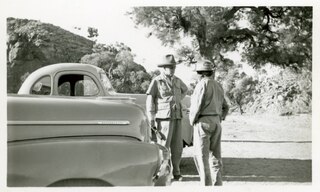Related Research Articles

Hermannsburg, also known as Ntaria, is an Aboriginal community in Ljirapinta Ward of the MacDonnell Shire in the Northern Territory of Australia, 125 kilometres (78 mi); west southwest of Alice Springs, on the Finke River, in the traditional lands of the Western Arrarnta people.
Theodor George Henry Strehlow was an Australian anthropologist and linguist. He studied the Arrernte Aboriginal Australians and their language in Central Australia.
Carl Friedrich Theodor Strehlow was an anthropologist, linguist and genealogist who served on two Lutheran missions in remote parts of Australia from May 1892 to October 1922. He was at Killalpaninna Mission in northern South Australia, from 1892 to 1894, and then Hermannsburg, 80 miles (130 km) west of Alice Springs, from 1894 to 1922. Strehlow was assisted by his wife Friederike, who played a central role in reducing the high infant mortality which threatened Aboriginal communities all over Australia after the onset of white settlement.

Arrernte or Aranda, or sometimes referred to as Upper Arrernte, is a dialect cluster in the Arandic language group spoken in parts of the Northern Territory, Australia, by the Arrernte people. Other spelling variations are Arunta or Arrarnta, and all of the dialects have multiple other names.

The Arrerntepeople, sometimes referred to as the Aranda, Arunta or Arrarnta, are a group of Aboriginal Australian peoples who live in the Arrernte lands, at Mparntwe and surrounding areas of the Central Australia region of the Northern Territory. Many still speak one of the various Arrernte dialects. Some Arrernte live in other areas far from their homeland, including the major Australian cities and overseas.
Warren Hedley Williams is an Aboriginal Australian singer, musician and songwriter from Ntaria in Central Australia. As of 2013 he worked as a broadcaster on CAAMA Radio in Alice Springs.
Kasper Gus Ntjalka Williams, known as Gus Williams, was an Aboriginal Australian country music singer who lived in Central Australia. He was known not only for his work in Aboriginal country music, but also as a leader of his people. He created the first electric country band in the Northern Territory, the Warrabri Country Bluegrass Band.
Thomas Sidney Dixon was a Catholic missionary known for his work with Indigenous peoples. He took up the cause of Max Stuart, an Arrernte Aboriginal convicted of murder in 1959.
The Namatjira Project is an Australian community cultural development project, launched in 2009, conducted by arts and social change company Big hART. It is based in the Aboriginal communities of Hermannsburg (NT) and Alice Springs in the Northern Territory of Australia. Its focus is the life and work of the late Albert Namatjira, an Arrernte watercolour landscape artist. The project undertakes community work and has developed an award-winning touring theatre show, Namatjira, which depicts "the commercial appropriation of Aboriginal experience".
Radke is a German surname and may refer to:

Friederike Johanna Henriette Strehlow née Keysser better known as Frieda Strehlow, was a German missionary who lived and worked at Hermannsburg in the Northern Territory of Australia in the early 1900s. She was best known for overcoming the high rate of infant mortality for Aboriginal children.

The Luritja or Loritja people, also known as Kukatja or Kukatja-Luritja, are an Aboriginal Australian people of the Northern Territory. Their traditional lands are immediately west of the Derwent River, that forms a frontier with the Arrernte people, with their lands covering some 27,000 square kilometres (10,300 sq mi). Their language is the Luritja dialect, a Western Desert language.
The massacre of Running Waters was the killing of 80 to 100 Arrernte men, women and children of the Southern Aranda language group of Aboriginal Australians by a raiding party of 50 to 60 Matuntara warriors in 1875. The massacre took place at Irbmangkara, a permanent water stretch of the Finke River about 200 kilometres (120 mi) south-west of Alice Springs in the Northern Territory of Australia.
Bertha Gwendoline Alexandra Strehlow was an educator and pioneer, the first wife of Ted Strehlow, an anthropologist and linguist who worked primarily with the Arrernte People. Although she is often forgotten, Strehlow was her husband's main supporter, and edited his works; she also published some accounts of their activities.

Friedrich Wilhelm Albrecht was a Lutheran missionary and pastor who was the superintendent at Hermannsburg Mission in Central Australia from 1926 to 1952 where he made a significant contribution.

Robert Henry Buck was an Australian pastoralist, bushman and drover who is best remembered as being one of the people to recover the body of Lewis Harold Bell Lasseter.
John Strehlow is an Australian stage director, playwright, and author. He is known for his work The tale of Frieda Keysser: Frieda Keysser & Carl Strehlow, an historical biography, about his grandparents, Lutheran missionaries Carl and Frieda Strehlow, who served for many years at Hermannsburg Mission in the Northern Territory.

Tiger Tjalkalyirri also known as Tiger Tjalkaljeri was a Pitjantjatjara man who was a guide, elder and land-rights campaigner for his people; especially in relation to Uluṟu-Kata Tjuṯa National Park.

Moses Tjalkabota, also known as Moses Tjalkabota Uraikuria or Blind Moses was a Western Arrernte man and Aboriginal evangelist who was born at Laprapuntja, east of Hermannsburg (Ntaria).

Friedrich Adolf Hermann Kempe, known as Hermann Kempe, was a Lutheran missionary and pastor who co-founded the Hermannsburg Lutheran Mission, now Ntaria community, in Central Australia. He lived there from 1877 to 1893.
References
- ↑ Peggy Glanville-Hicks AddressListening to History: Some Proposals for Reclaiming the Practice of Music. By John Rose Archived 21 November 2008 at the Wayback Machine
- 1 2 3 4 5 6 7 8 9 10 11 12 Strahle, Graham (29 May 2019). "Indigenous Women's Only Ntaria Choir Reaches Back To Bach". Music Australia. Retrieved 8 November 2022.
- 1 2 3 4 5 6 7 8 9 "The Hermannsburg Choir". Hermannsburg Historic Precinct. Retrieved 8 November 2022.
- 1 2 "Choir". Hermannsburg Historic Precinct. Retrieved 8 November 2022.
- 1 2 3 Westwood, Matthew (16 September 2007). "Religious choirs a constant across desert generations". The Australian . Archived from the original on 16 September 2007. Retrieved 8 November 2022.
- 1 2 3 4 5 Barwick, Rohan (16 July 2021). "Historic Hermannsburg Choir tour celebrated in new book" (audio, 30 mins). ABC Darwin. The Late Lunch. Australian Broadcasting Corporation . Retrieved 10 November 2022.
- 1 2 "Gus Williams (1937-2010)". Hermannsburg Historic Precinct. Retrieved 8 November 2022.
- 1 2 Radke, O. (2021). Hermannsburg Choir on Tour - Remembering the 1967 Choir Tour; Including the Original 'Choir Tour Diary'. Friends of the Strehlow Research Centre. ISBN 978-0-6485919-2-4 . Retrieved 10 November 2022.
- ↑ "Thousands gather in Stuttgart for Germany's festival of faith and action". World Council of Churches. 4 June 2015. Retrieved 8 November 2022.
- 1 2 The Song Keepers at IMDb
- ↑ "Q&A with Naina Sen". MIFF 2022. Retrieved 11 November 2022.
- ↑ Schultz, Andrew; et al. (2004), Journey to Horseshoe Bend, a cantata based on the novel by TGH Strehlow (CD), Australian Broadcasting Corporation, ABC 476 2266, retrieved 29 November 2012